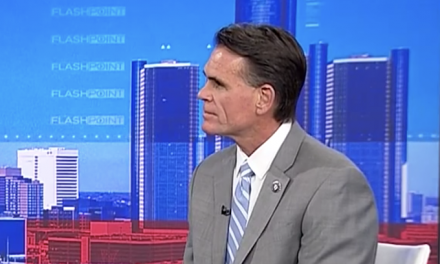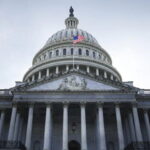The latest defense authorization bill signed into law by President Trump on Dec. 20 contains new measures requiring the federal government to protect the nation from the danger of nuclear-blast-produced electromagnetic pulse (EMP) attacks and similar solar-produced electronic disruptions.
The law’s language gives legal authority to Mr. Trump’s March 2019 executive order directing the government to harden critical infrastructure against an EMP strike.
Under the law, the Federal Emergency Management Agency administrator is in charge of coordinating responses to and recovery from EMP attacks or major solar storms that are capable of disrupting all electronic devices over wide areas.
The agency will lead a major effort to create a network of systems to alert the public and provide a warning system to deal with EMP strikes and communicate with the public should electric systems be disrupted.
The goal is to better protect critical infrastructure — especially electric power grids — that could produce catastrophic damage and loss of life if they were shut down. The Pentagon is tasked under the law with conducting research on the impact of EMP attacks on critical infrastructure.
The Pentagon also will conduct intelligence assessments every four years into EMP and solar storm threats, with the first assessment mandated for completion by March, and produce reports to Congress every four years on the use of technological steps that can be used to harden infrastructure from electromagnetic disturbances.
Federal agencies will have until June to draw up specific plans and procedures for responding to EMP attacks and major geomagnetic disturbances. Nationwide exercises to practice responses to EMP attacks also will be held.
A congressional EMP commission disclosed last January that several nations, including China and Russia, are secretly developing nuclear weapons capable of producing super-EMP waves that can destroy all electronic devices over areas of hundreds of miles.
An EMP is produced as part of a nuclear detonation. Geomagnetic disturbances are caused by eruptions on the sun that send magnetized particles into the Earth’s magnetic field.
Peter Pry, a leading advocate for greater efforts to deal with EMP threats, said the legislation is a good first step and could prevent a future president from reversing Mr. Trump’s executive order.
“In less than one year since President Trump signed his EMP executive order, it has been given the force of law by Congress in the FY2020 National Defense Authorization Act, resulted in tasking the National Guard to begin planning for national EMP preparedness, and moved states like Wyoming to initiate their own emergency plans for an EMP catastrophe,” Mr. Pry said. “That is amazing progress but could be derailed if Washington bureaucrats and the utilities underestimate the EMP threat.”
The Wyoming state office in charge of homeland security recently added an annex to its emergency response plan to respond to power outages caused by EMP or solar storms.
The law does not resolve one problem related to EMP protection: the control of the U.S. electric power grid by private utilities.
Electric power companies in the past have opposed efforts to harden their infrastructure over concerns about costs.
The law is a setback for arms control advocates who have argued that the threat is overstated and have opposed hardening U.S. infrastructure against EMP attacks as unnecessary.
North Korea, now armed with nuclear-armed missiles capable of reaching U.S. soil, has been seen by some as capable of conducting an EMP strike above the United States. Opponents of tough EMP countermeasures, however, say Pyongyang would face certain regime-ending nuclear retaliation for such an attack.
Air Force Lt. Gen. Steven Kwast, until recently the commander of the Air Education and Training Command in San Antonio, sounded the alarm on EMP threats in May.
“The American people need to understand that we built Western civilization on electricity and information,” said Gen. Kwast, who has since retired. “We see evidence of China and Russia looking at that as a vulnerability in American society, and we have to be mindful of that.”
CHINA’S NEW CARRIER — FOR SHOW?
China commissioned its first indigenously built aircraft carrier last month, but experts say they see signs that the ship is not fully operational despite several sea trials.
The Shandong was commissioned on Dec. 18, and state-run Chinese media announced that the warship will be based in the contested South China Sea, where U.S. and Chinese warships have faced off over Beijing’s claims to owning most of the strategic waterway.
The Communist Party newspaper People’s Daily said the “strategic focus” of the Shandong will be in waters around the South China Sea and credits part of China’s goal of “achieving domination” in both air and sea domains.
“Recently, military vessels and aircraft from some nations have been carrying out so-called freedom of navigation operations in the South China Sea, stirring up troubles and challenging China’s national sovereignty,” said the newspaper, referring to U.S. and allied warship passages in the sea.
The strike group said it is “very likely that it will have face-to-face encounters with foreign military vessels,” the newspaper said in a commentary.
Retired Navy Capt. Jim Fanell, a former Pacific Fleet intelligence chief, said he strongly doubts Chinese claims that the carrier was “built independently” and does not rely on foreign technology.
China has stolen American and other foreign military technology on a grand scale through both cyber and human espionage operations.
For example, Chinese hackers broke into Boeing’s networks beginning in 2009 and stole corporate secrets on the Air Force’s frontline C-17 transport. The secrets allowed the Chinese to obtain an estimated $40 billion in U.S. development for a cyberspying operation that cost Beijing less than $400,000.
The Boeing C-17 secrets were then used to build the Chinese Y-20 military transport.
Capt. Fanell said the new carrier lacked signs of rigorous training and testing prior to its commissioning.
The warship could be merely a “show” weapons platform that has not undergone significant flight operations.
“Maybe it’s my 20 years on some of the oldest USN aircraft carriers — USS Coral Sea (CV-43) and USS Kitty Hawk (CV-63) — but you cannot conduct flight operations with jet aircraft without having oil, grease and lots of burnt rubber all over the place,” said Capt. Fanell, noting images of the Shandong’s clean deck.
“Sure, she’s a brand-new carrier and has the ‘off the floor room’ appearance, but after nine or 10 sea trials and transits to the South China Sea that supposedly included flight operations, I’d expect to see a bit more grit and grease. I don’t see any skid marks. That is not normal.”
Capt. Fanell said he believes China’s navy “still has some heavy lifting to do when it comes to being a real carrier naval force.”
The deployment is part of a disturbing trend of China’s buildup of naval forces and should prompt the U.S. Navy to better prepare to confront the Chinese.
“Given the immaturity of the PLA Navy aircraft carrier force, U.S. military forces must boldly and aggressively conduct intelligence, surveillance and reconnaissance operations on Chinese carriers whenever they are at sea in order to better perfect our capacity to sink them if required,” he said.
PRAGUE CUTS SISTER CITY TIE TO BEIJING
The mayor of Prague, the capital of the Czech Republic that remains staunchly anti-communist after decades as a Soviet satellite state, has cut off a sister city agreement with Beijing.
Mayor Zdenek Hrib canceled the agreement in October after China refused to enter talks about removing a statement in the agreement requiring Prague to agree to China’s policy of not recognizing Taiwan as an independent state.
China responded by threatening to use its economic might in pulling investments and canceling cultural exchanges.
The mayor then announced he would sign a sister city agreement with Taipei, the capital city of Taiwan.
Mr. Hrib said he regards China as an unreliable business partner. “How could we consider entrusting a company from such a country to build our critical digital infrastructure?” he asked, according to Germany’s Die Welt news outlet.
© Copyright (c) 2020 News World Communications, Inc.
—-
This content is published through a licensing agreement with Acquire Media using its NewsEdge technology.



















Recent Comments